IBM Z
IBM Z[1] is a family name used by IBM for all of its z/Architecture mainframe computers from the Z900 on. In July 2017, with another generation of products, the official family was changed to IBM Z from IBM z Systems; the IBM Z family now includes the newest model the IBM z15, as well as the z14 and the z13 (released under the IBM z Systems/IBM System z names), the IBM zEnterprise models (in common use the zEC12 and z196), the IBM System z10 models (in common use the z10 EC), the IBM System z9 models (in common use the z9EC) and IBM eServer zSeries models (in common use refers only to the z900 and z990 generations of mainframe).
| History of IBM mainframes, 1952–present |
|---|
| Market name |
|
| Architecture |
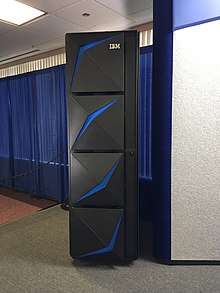
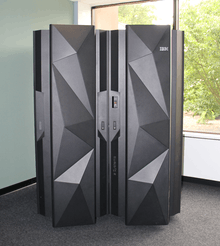
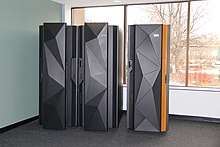
Architecture
The zSeries, zEnterprise, System z and IBM Z families were named for their availability – z stands for zero downtime. The systems are built with spare components capable of hot failovers to ensure continuous operations.[2]
The IBM Z family maintains full backward compatibility. In effect, current systems are the direct, lineal descendants of System/360, announced in 1964, and the System/370 from the 1970s. Many applications written for these systems can still run unmodified on the newest IBM Z system over five decades later.[3]
Virtualization
Virtualization is required by default on IBM Z systems. First layer virtualization is provided by the Processor Resource and System Manager (PR/SM) to deploy one or more Logical Partitions (LPARs). Each LPAR supports a variety of operating systems. A hypervisor called z/VM can also be run as the second layer virtualization in LPARs to create as many virtual machines (VMs) as there are resources assigned to the LPARs to support them. The first layer of IBM Z virtualization (PR/SM) allows a z machine to run a limited number of LPARs (up to 80 on the IBM z13). These can be considered virtual "bare metal" servers because PR/SM allows CPUs to be dedicated to individual LPARs. z/VM LPARs allocated within PR/SM LPARs can run a very large number of virtual machines as long as there are adequate CPU, memory, and I/O resources configured with the system for the desired performance, capacity, and throughput.
IBM Z's PR/SM and hardware attributes allow compute resources to be dynamically changed to meet workload demands. CPU and memory resources can be non-disruptively added to the system and dynamically assigned, recognized, and used by LPARs. I/O resources such as IP and SAN ports can also be added dynamically. They are virtualized and shared across all LPARs. The hardware component that provides this capability is called the Channel Subsystem. Each LPAR can be configured to either "see" or "not see" the virtualized I/O ports to establish desired "shareness" or isolation. This virtualization capability allows significant reduction in I/O resources because of its ability to share them and drive up utilization.
PR/SM on IBM Z has earned Common Criteria Evaluation Assurance Level (EAL) 5+ security certification,[4] and z/VM has earned Common Criteria EAL4+ certification.[5]
List of models (reverse chronological order)
Since the move away from the System/390 name, a number of IBM Z models have been released. These can be grouped into families with similar architectural characteristics.
IBM z15
IBM z14
The dual frame z14, launched in July 2017,[10] and the single frame z14, launched in April 2018,[11] are based on the z14 chip, a 10-core processor running at 5.2 GHz.[12][13] A z14 system can have a maximum of 240 Processing Unit (PU) cores, 170 of which can be configured to the customer's specification to run applications and operating systems, and up to 32 TB usable redundant array of independent memory (RAIM), some of which can be configured as Virtual Flash Memory (VFM). Each PU can be characterized as a Central Processor (CP), Integrated Firmware Processor (IFP), Integrated Facility for Linux (IFL) processor, Integrated Information Processor (zIIP), Internal Coupling Facility (ICF) processor, additional System Assist Processor (SAP) or as a spare. The focus of the IBM Z systems are pervasive encryption as the z14 processor has plenty of hardware assisted cryptography features (AES, DES, TDES, SHA, Random number generator).[14][15]
IBM System z13
Launched on January 13, 2015,[16][17] the z13 is based on the z13 chip, a 5 GHz octa-core processor. A z13 system can have a maximum of 168 Processing Unit (PU) cores, 141 of which can be configured to the customer's specification to run applications and operating systems, and up to 10144 GiB (usable) of redundant array of independent memory (RAIM). Each PU can be characterized as a Central Processor (CP), Integrated Firmware Processor (IFP), Integrated Facility for Linux (IFL) processor, z Integrated Information Processor (zIIP), Internal Coupling Facility (ICF) processor, additional System Assist Processor (SAP) or as a spare. The z Application Assist Processor (zAAP) feature of previous zArchitecture processors is now an integrated part of the z13's zIIP.[18]
The z Systems z13s (2965 series) was introduced on February 17, 2016[19]
The z13 and z13s are the last z Systems servers to support running an operating system in ESA/390 architecture mode.[20]
IBM zEnterprise System
The IBM zEnterprise System (zEnterprise), announced in July 2010, with the z196 model, is designed to offer both mainframe and distributed server technologies in an integrated system. The zEnterprise System consists of three components.[21] First is a System z server. Second is the IBM zEnterprise BladeCenter Extension (zBX). Last is the management layer, IBM zEnterprise Unified Resource Manager (zManager), which provides a single management view of zEnterprise resources. The zEnterprise is designed to extend mainframe capabilities – management efficiency, dynamic resource allocation, serviceability – to other systems and workloads running on AIX on POWER7, and Microsoft Windows or Linux on x86.[22]
The zEnterprise BladeCenter Extension (zBX) is an infrastructure component that hosts both general purpose blade servers and appliance-like workload optimizers which can all be managed as if they were a single mainframe. The zBX supports a private high speed internal network that connects it to the central processing complex, which reduces the need for networking hardware and provides inherently high security.
The IBM zEnterprise Unified Resource Manager integrates the System z and zBX resources as a single virtualized system and provides unified and integrated management across the zEnterprise System. It can identify system bottlenecks or failures among disparate systems and if a failure occurs it can dynamically reallocate system resources to prevent or reduce application problems. The Unified Resource Manager provides energy monitoring and management, resource management, increased security, virtual networking, and information management from a single user interface.
On April 8, 2014, in honor of the 50th anniversary of the System/360 mainframe, IBM announced[23] the release of its first converged infrastructure solution based on mainframe technology. Dubbed the IBM Enterprise Cloud System,[24] this new offering combines IBM mainframe hardware, software, and storage into a single system and is designed to compete with competitive offerings from VCE, HP, and Oracle. According to IBM, it is the most scalable Linux server available with support for up to 6,000[23] virtual machines in a single-footprint.
In June 2014, IBM announced[25] it had shipped its first Enterprise Cloud System to Vissensa, a UK-based managed service provider.
zEnterprise BC12
Introduced in July 2013, the zEnterprise BC12 (zBC12) is based on an upscaled z114, running 18 zEC12 processors at 4.2 GHz and up to 489 GB RAM. It is available in two models, the H06 and the H13 with one and two processing drawers respectively. The zBC12 can connect to the zBX expansion system. IBM is offering a special version of the zBC12 called the Enterprise Linux Server,[26] running only Linux hosts on top of its z/VM hypervisor, targeting large migrations from x86-based Linux installations.
zEnterprise EC12
Introduced in August 2012, the zEnterprise EC12 (zEC12) is based on the zEC12 chip, a 5.5 GHz hexa-core out-of-order CISC-based zArchitecture processor. The zEC12 can have a maximum of 120 cores, 101 of which are customer configurable to run operating systems and applications.[27] The maximum number of cores available in a particular model of the zEC12 is denoted by the model name. For example, the H20 has up to 20 cores orderable for direct customer use, plus spare and a special I/O processor core type, the System Assist Processor. Each core can be characterized as a Central Processor (CP), Integrated Facility for Linux (IFL) processor, z Application Assist Processor (zAAP), z10 Integrated Information Processor (zIIP), Internal Coupling Facility (ICF) processor, or additional System Assist Processor (SAP). The zEnterprise EC12 allows up to 3 TB (usable) of redundant array of independent memory (RAIM).
The EC12 has 50% higher total capacity than the z196 (up to 78,000 MIPS), and supports Transactional Execution and Flash Express – integrated SSDs which improve paging and certain other I/O performance.
zEnterprise 114
The zEnterprise 114 (z114) is powered by up to 14 z196 out-of-order CISC-based zArchitecture microprocessors running at 3.8 GHz. The z114 offers 130 capacity settings across two models and is designed to offer the hybrid capabilities of the zEnterprise System with a lower capacity, an lower energy usage, and lower price.[28] Each core can be characterized as a Central Processor (CP), Integrated Facility for Linux (IFL) processor, z Application Assist Processor (zAAP), z10 Integrated Information Processor (zIIP), Internal Coupling Facility (ICF) processor, or additional System Assist Processor (SAP). The z114 supports up to 248 GB (usable) of redundant array of independent memory (RAIM).
zEnterprise 196
The zEnterprise 196's microprocessor is the z196 chip, a 5.2 GHz quad-core out-of-order CISC-based z/Architecture processor. The z196 can have a maximum of 24 processors giving a total of 96 cores, 80 of which are directly available to run operating systems and applications.[29] The number of cores available in a particular model of the z196 is denoted by the model name. For example, the M15 has 15 cores available for direct customer use, plus spare and service processor cores. Each core can be characterized as a Central Processor (CP), Integrated Facility for Linux (IFL) processor, z Application Assist Processor (zAAP), z10 Integrated Information Processor (zIIP), Internal Coupling Facility (ICF) processor, or additional System Assist Processor (SAP). The zEnterprise also supports x86 or Power ISA blades attached via the zEnterprise BladeCenter Extension (zBX). The zEnterprise 196 allows up to 3 TB (usable) of redundant array of independent memory (RAIM).
The zEnterprise z196 has twice the memory capacity of the z10, and 60% higher total capacity than the z10 (up to 52,000 MIPS). It supports the BladeCenter Extension (zBX) and Unified Resource Manager.
Enterprise Class
The zEC12 is available in five hardware models: H20, H43, H66, H89 and HA1.[30] The model number is based on the number of cores available for customer workloads. Additional cores are reserved as spares, SAPs and IFPs.
| Model | CPs | IFLs | zAAPs / zIIPs | ICFs | SAPs | IFPs | Spares | Memory (GB) |
|---|---|---|---|---|---|---|---|---|
| H20 | 1–20 | 0–20 | 0–10 / 0–10 | 0–20 | 4–8 | 1 | 2–20 | 32–704 |
| H43 | 1–43 | 0–43 | 0–21 / 0–21 | 0–43 | 8–16 | 1 | 2–43 | 32–1392 |
| H66 | 1–66 | 0–66 | 0–33 / 0–33 | 0–66 | 12–24 | 1 | 2–66 | 32–2272 |
| H89 | 1–89 | 0–89 | 0–44 / 0–44 | 0–89 | 16–32 | 1 | 2–89 | 32–3040 |
| HA1 | 1–101 | 0–101 | 0–50 / 0–50 | 0–101 | 16–32 | 1 | 2–101 | 32–3040 |
The z196 is available in five hardware models: M15, M32, M49, M66 and M80. The model number is based on the number of cores available for customer workloads.[31] Additional cores are reserved as spares and as SAPs.
| Model | CPs | IFLs | zAAPs / zIIPs | ICFs | SAPs | Spares | zBX | Memory (GB) |
|---|---|---|---|---|---|---|---|---|
| M15 | 0–15 | 0–15 | 0–7 / 0–7 | 0–15 | 3 | 2–15 | 0–1 | 32–752 |
| M32 | 0–32 | 0–32 | 0–16 / 0–16 | 0–16 | 6 | 2–32 | 0–1 | 32–1520 |
| M49 | 0–49 | 0–49 | 0–24 / 0–24 | 0–16 | 9 | 2–49 | 0–1 | 32–2288 |
| M66 | 0–66 | 0–66 | 0–33 / 0–33 | 0–16 | 12 | 2–66 | 0–1 | 32–3056 |
| M80 | 0–80 | 0–80 | 0–40 / 0–40 | 0–16 | 14 | 2–80 | 0–1 | 32–3056 |
Business Class
The zBC12 was introduced in July 2013 and is available in two hardware models, the H06 and the H13. It's designed to serve the mid-range business segment and can be configured to be a Linux virtualization server, in a version called the Enterprise Linux Server. The H13 has 18 processor cores, with up to 13 configurable. The H06 has nine, with up to six configurable.
| Model | CPs | IFLs | zAAPs / zIIPs | ICFs | SAPs | IFPs | Spares | zBX | Memory (GB) |
|---|---|---|---|---|---|---|---|---|---|
| H06 | 0–6 | 0–6 | 0–4 / 0–4 | 0–6 | 2 | 1 | 0 | 0–1 | 8–240 |
| H13 | 0–6 | 0–13 | 0–8 / 0–8 | 0–13 | 2 | 1 | 2 | 0–1 | 16–496 |
The z114 is available in two hardware models: M05 and M10. Introduced in July, 2011, this system is designed to extend the benefits of the zEnterprise System to the mid-range business segment. Like the z196, the z114 is fully compatible with the zBX and the URM and also features the mission-critical server design elements. The z114 features up to 14 cores (up to 10 configurable) with a clock speed of 3.8 GHz. The z114 is physically approximately half the size of the z196.
| Model | CPs | IFLs | zAAPs / zIIPs | ICFs | SAPs | Spares | zBX | Memory (GB) |
|---|---|---|---|---|---|---|---|---|
| M05 | 0–5 | 0–5 | 0–2 / 0–2 | 0–5 | 2–4 | 0 | 0–1 | 8–120 |
| M10 | 0–5 | 0–10 | 0–5 / 0–5 | 0–10 | 2–4 | 2 | 0–1 | 16–248 |
IBM System z10
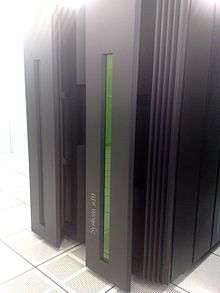
The IBM System z10 servers supported more memory than previous generation systems and can have up to 64 central processors (CPs) per frame. The full speed z10 processor's uniprocessor performance was up to 62% faster than that of the z9 server, according to IBM's z10 announcement, and included these other features:
- 50% more performance and 70% more usable capacity. The new 4.4 GHz processor was designed to address CPU intensive workloads and support large scale server consolidation on the mainframe.
- Just-in-time capacity and management – monitoring of multiple systems based on Capacity Provisioning and Workload Manager (WLM) definitions. When the defined conditions are met, z/OS can suggest capacity changes for manual activation from a z/OS console, or the system can add or remove temporary capacity automatically and without operator intervention.[32]
Specific models from this family include:
- z10 Business Class (2098 series), introduced on October 21, 2008
- z10 Enterprise Class (2097 series), introduced on February 26, 2008
IBM System z9
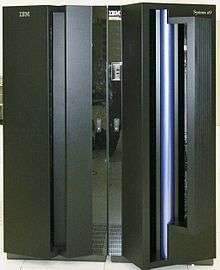
In July 2005, IBM announced a new family of servers – the System z9 family – with the IBM System z9 Enterprise Class (z9 EC) and the IBM System z9 Business Class (z9 BC) servers. The System z9 servers offered:
- More flexibility on the enterprise class servers in customizing and sizing the capacity of the general purpose processors (CPs) that reside in the server. The z9 EC servers offered four different sub-capacity settings when run with eight or fewer general purpose processors.
- zIIP engines. The zIIP is designed so that a program can work with z/OS to have all or a portion of its Service Request Block (SRB) dispatched work directed to the zIIP to help free up capacity on the general purpose processor which may make it available for use by other workloads running on the server.
- MIDAW. The Modified Indirect Data Address Word (MIDAW) facility offers an alternative facility for a channel program to be constructed. It is designed to improve performance for native FICON applications that use extended format datasets (including DB2 and VSAM) by helping to improve channel utilization, reduce channel overhead, and improve I/O response times.
- CP Assist for Cryptographic Functions (CPACF) is shipped on every CP and IFL processor in support of clear key encryption. CPACF was enhanced for System z9 processors to include support of the Advanced Encryption Standard (AES) for 128-bit keys, Secure Hash Algorithm-256 (SHA-256), CPACF offers DES, Triple DES and SHA-1.
Specific models from this family include:
- z9 Business Class (2096 series), successor to the z890 and smallest z990 models (2006)
- z9 Enterprise Class (2094 series), introduced in 2005, initially as z9-109, beginning the new System z9 line
IBM zSeries family
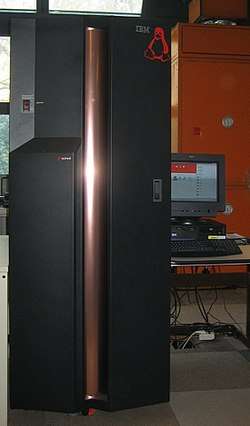
The zSeries family, which includes the z900, z800, z990 and z890, introduced IBM's newly designed 64-bit z/Architecture to the mainframe world. The new servers provide more than four times the performance of previous models. In its 64-bit mode the new CPU is freed from the 31-bit addressing constraints of its predecessors. Major features of the eServer zSeries family:
- Based on z/Architecture (64-bit real and virtual addresses), as opposed to earlier ESA/390 (31-bit) used in S/390 systems yet emphasizing the backwards compatibility the ESA/390 applications are fully compatible with z/Architecture
- First zSeries Superscalar server (z990) – A superscalar processor allows concurrent execution of instructions by adding additional resources onto the microprocessor to achieve more parallelism by creating multiple pipelines, each working on its own set of instructions.
- Offers up to 32 central processors (CPs) per frame
- Frames can be coupled in up to a 32-frame Sysplex, with each frame physically separated up to 100 kilometers
- Supports the z/OS, Linux on IBM Z, z/VM, z/VSE, and z/TPF operating systems
- Support of multiple I/O channel subsystem – or multiple Logical Channel Subsystem (LCSS). The z990 allows for support of up to four LCSS – offering support for up to 4 times the previous 256 channel limit
- Support for zAAP processors. These specialty processors allow IBM JVM processing cycles to be executed on the configured zAAPs with no anticipated modifications to the Java application(s). This means that deployment and integration of new Java technology-based workloads can happen on the very same platform as heritage applications and core business databases in a highly cost-effective manner
Specific models from this family included:
- z890 (2086 series), successor to the z800 and smaller z900 models (2004)
- z990 (2084 series), successor to larger z900 models (2003)
- z800 (2066 series), entry-level, less powerful variant of the z900 (2002)
- z900 (2064 series), for larger customers (2000)
Processor book
A processor book is a modular card in IBM mainframes that contains processors, memory, and I/O connections.[33][34] A multi-chip module is welded onto each processor book for the z196 model.[35]
Features
Processors and memory
zEnterprise EC12
The zEnterprise EC12 (zEC12) is based on the zEC12 chip, a 5.5 GHz hexa-core out-of-order CISC-based zArchitecture processor. The zEC12 can have a maximum of 120 cores, 101 of which are customer configurable to run operating systems and applications.[27] The maximum number of cores available in a particular model of the zEC12 is denoted by the model name. For example, the H20 has up to 20 cores orderable for direct customer use, plus spare and a special I/O processor core type, the System Assist Processor. Each core can be characterized as a Central Processor (CP), Integrated Facility for Linux (IFL) processor, z Application Assist Processor (zAAP), z10 Integrated Information Processor (zIIP), Internal Coupling Facility (ICF) processor, or additional System Assist Processor (SAP). The zEnterprise EC12 allows up to 3 TB (usable) of redundant array of independent memory (RAIM).
zEnterprise BC12
The zEnterprise BC12 (zBC12) is based on an upscaled z114, running 18 zEC12 processors at 4.2 GHz and up to 489 GB RAM. It's available in two models, the H06 and the H13 with one and two processing drawers respectively. The zBC12 can connect to the zBX expansion system. IBM is offering a special version of the zBC12 called the Enterprise Linux Server running only Linux hosts on top of its z/VM hypervisor targeting large migrations from x86 based Linux installations.
zEnterprise 114
The zEnterprise 114 (z114) is powered by up to 14 z196 out-of-order CISC-based zArchitecture microprocessors running at 3.8 GHz. The z114 offers 130 capacity settings across two models and is designed to offer the hybrid capabilities of the zEnterprise System with a lower capacity, an lower energy usage, and lower price.[28] Each core can be characterized as a Central Processor (CP), Integrated Facility for Linux (IFL) processor, z Application Assist Processor (zAAP), z10 Integrated Information Processor (zIIP), Internal Coupling Facility (ICF) processor, or additional System Assist Processor (SAP). The z114 supports up to 248 GB (usable) of redundant array of independent memory (RAIM).
zEnterprise 196
The zEnterprise 196's microprocessor is the z196 chip, a 5.2 GHz quad-core out-of-order CISC-based z/Architecture processor. The z196 can have a maximum of 24 processors giving a total of 96 cores, 80 of which are directly available to run operating systems and applications.[29] The number of cores available in a particular model of the z196 is denoted by the model name. For example, the M15 has 15 cores available for direct customer use, plus spare and service processor cores. Each core can be characterized as a Central Processor (CP), Integrated Facility for Linux (IFL) processor, z Application Assist Processor (zAAP), z10 Integrated Information Processor (zIIP), Internal Coupling Facility (ICF) processor, or additional System Assist Processor (SAP). The zEnterprise also supports x86 or Power ISA blades attached via the zEnterprise BladeCenter Extension (zBX). The zEnterprise 196 allows up to 3 TB (usable) of redundant array of independent memory (RAIM).
Operating systems
The z15, z14, z13, zEC12, zBC12, z114 and z196 support the IBM operating systems: z/OS, z/VM, z/VSE, and z/TPF. Other operating systems available include Linux on IBM Z, such as Red Hat Enterprise Linux 6 and SUSE Linux Enterprise Server 11.[31] In November, 2011, IBM introduced Microsoft Windows Server 2008 support via x86 processor-based blades that plug into IBM's zEnterprise BladeCenter Extension (zBX). The zBX also supports the IBM WebSphere DataPower Integrated Appliance XI50 for zEnterprise (DataPower XI50z).
The zBX supports up to 112 blade modules. There is a redundant, secure 10 Gigabit Ethernet connection between the zBX and the server providing a private data network. There is also a 1 Gigabit Ethernet connection for management.
BladeCenter Extension (zBX)
The zEnterprise System supports an optional zEnterprise BladeCenter Extension (zBX). This add-on infrastructure supports redundant top-of-Rack switches, redundant power supplies, extra blowers, and IBM BladeCenter chassis. This add-on chassis allows POWER7 and x86 blade servers to be integrated with and managed from the mainframe.[36] The Gameframe installation at Hoplon Infotainment is an example of a hybrid mainframe.
The zBX supports up to 112 blade modules.[37] The zBX and the System Z server are connected by a redundant, secure 10 Gigabit Ethernet connection, providing a private data network. There is also a 1 Gigabit Ethernet connection for management.
Unified Resource Manager
The zEnterprise Unified Resource Manager (zManager) allows the supported zBX platforms to be virtualized into a single system for management. It also allows for the prioritization of certain workloads in the system. The Resource Manager can monitor the various platforms for signs of bottlenecks or faults and modify the overall system to recover, maintaining a specified quality of service level.[38]
Liquid cooling
The zEC12 and z196 support external liquid cooling. Customers have the option of purchasing their mainframe with a water-cooled heat exchanger.[39]
PU characterization
Each purchased PU (processor unit) is characterized as one of a variety of types:
- CP: Central processor; The standard processors. For use with any supported operating system and user applications.
- IFL: Integrated Facility for Linux; Exploited by Linux and for z/VM processing in support of Linux. It is not possible to IPL operating systems other than z/VM or Linux on an IFL.
- zAAP: Application Assist Processor; Exploited under z/OS for designated workloads, which include the IBM JVM and XML System Services functions.
- zIIP: Integrated Information Processor; Exploited under z/OS for designated workloads, which include various XML System Services, IPSec offload, certain parts of IBM DB2 DRDA, star schema, IBM HiperSockets for large messages, and the IBM GBS Scalable Architecture for Financial Reporting.
- ICF: Internal Coupling Facility; Used for z/OS clustering, running exclusively the Coupling Facility Control Code (CFCC).
- SAP: System Assist Processor; Offloads and manages I/O operations.
- IFP: Integrated Firmware Processor; reserved for managing new generation of PCIe adapters in zEC12 and zBC12.
- Spares: exclusively reserved to provide failover in the event of a processor (CP, IFL, zAAP, zIIP, ICF, SAP or IFP) failure.
Also it's possible to run a zAAP-eligible workload on zIIPs if no zAAPs are enabled. IBM does not impose any software charges on work that is dispatched on zAAP and zIIP processors.
The addition of IFLs, zAAPs, zIIPs, ICFs, SAPs or IFPs does not change the system capacity setting or its MSU rating, only CPs do.
See also
- List of IBM products
- Linux on IBM Z
- zAAP
- zIIP
- Peer to Peer Remote Copy
- Extended Remote Copy
- LPAR
- HiperSocket
- ESCON
- FICON
- IBM Parallel Sysplex
- IBM Secure Service Container
- Hercules emulator
- z/VM
- z/OS
- OpenSolaris for System z
- Gameframe
- IBM z13 (microprocessor)
- IBM z196 (microprocessor)
- IBM zEC12 (microprocessor)
- z/Architecture
References
- IBM Mainframes - IBM Z, IBM, retrieved 2015-04-20
- Selecting System z operating environments: Linux or z/OS?
- "Mainframe strength: Continuing compatibility". z/OS basic skills information center. IBM. Retrieved 12 October 2012.
- Bannan, Karen. "The zEnterprise EC12 Raises Enterprise Security While Boosting Analytics and Cloud Performance". IBM Systems Magazine. IBM. Retrieved 29 August 2014.
- "z/VM Security and Integrity Resources". IBM. Retrieved 29 August 2014.
- "IBM - KVM for IBM z Systems". IBM. Retrieved 14 March 2016.
- "IBM Unveils z15 With Industry-First Data Privacy Capabilities" (Press release). IBM. September 12, 2019.
- "IBM z15 Technical Introduction - A draft IBM Redbooks publication". IBM. September 11, 2019.
- "IBM z15 Technical Guide - A draft IBM Redbooks publication". IBM. September 11, 2019.
- "IBM Mainframe Ushers in New Era of Data Protection" (Press release). IBM. July 17, 2017.
- "IBM unveils new cloud-ready mainframe based on single-frame design - IBM IT Infrastructure Blog". IBM IT Infrastructure Blog. 2018-04-10. Retrieved 2018-04-13.
- "The enterprise mainframe server – the core of trusted digital experiences".
- "IBM z14 Technical Guide - A draft IBM Redbooks publication".
- "IBM z14 (z14)" (PDF). IBM.
- Octavian Lascu; Hervey Kamga; Esra Ufacik; Bo Xu; John Troy; Frank Packheiser; Michal Kordyzon (October 2018). "IBM z14 (3906) Technical Guide" (PDF). IBM. SG24-8451-01.
- "IBM Launches z13 Mainframe". IBM (Press release). IBM. Retrieved 20 April 2015.
- Niccolai, James (January 13, 2015). "IBM's new z13 mainframe eats mobile app data for lunch". Computerworld.
- "IBM z13 and IBM z13s Technical Introduction" (PDF). p. 21. Retrieved 2018-11-11.
- "IBM Unveils New Mainframe for Encrypted Hybrid Clouds" (Press release). IBM. February 16, 2016.
- Accommodate functions for the z13 server to be discontinued on future servers
- "1.3 Introducing the zEnterprise System". IBM zEnterprise System Technical Introduction (PDF). IBM. August 2011. SG24-7832-01. Retrieved 16 April 2019.
- "IBM's mainframe-blade hybrid to do Windows". The Register. Retrieved 12 October 2012.
- "IBM Brings New Cloud Offerings, Research Projects and Pricing Plans to the Mainframe". IBM News Room (Press release). IBM. 8 April 2014. Retrieved 2014-07-18.
- "IBM Enterprise Cloud System". IBM System z: Enterprise Cloud System. IBM. 8 April 2014. Retrieved 2014-07-18.
- Taft, Darryl (2014-06-27). "IBM Ships Its First Enterprise Cloud System to Vissensa". eWeek. Retrieved 2014-07-18.
- "IBM unveils new "mainframe for the rest of us"". Ars Technica.
- "IBM zEnterprise EC12 Technical Guide" (PDF). IBM. August 28, 2012. Retrieved August 30, 2012.
- "IBM zEnterprise 114 Technical Guide" (PDF). IBM. February 27, 2012. Retrieved October 1, 2012.
- Morgan, Timothy Prickett (July 19, 2010). "IBM zEnterprise 196 mainframe due July 22". The Register. Retrieved September 1, 2010.
- "IBM zEnterprise EC12 Specifications". IBM. Retrieved 2012-08-29.
- "IBM zEnterprise 196 - Specifications". IBM. Retrieved September 1, 2010.
- "7.3.10 Capacity Provisioning Manager". IBM System z10 Business Class Technical Overview. IBM. November 2009. ISBN 9780738433769. SG24-7632-01. Retrieved 2020-01-19.
- Introduction to the New Mainframe. IBM Corporation. March 2011. p. 6.
- "Multichip Module Packaging and Its Impact on Architecture" (PDF).
- "IBM's z12 mainframe engine makes each clock count". The Register. Retrieved 14 April 2017.
- Dignan, Larry (July 21, 2010). "IBM unveils hybrid mainframe; 'System of system' eyes data center consolidation". ZDNet. Retrieved September 1, 2010.
- "IBM zEnterprise System Technical Introduction" (PDF). IBM. Section 1.5.6 zEnterprise BladeCenter Extension. Retrieved 14 May 2019.
- Taft, Darryl (July 22, 2010). "IBM Unveils New zEnterprise Mainframe". eWeek.com. Retrieved September 2, 2010.
- Thibodeau, Patrick (September 1, 2010). "Water cooling returns to IBM mainframe". Computer World. Retrieved September 1, 2010.
Further reading
- Burt, Jeffrey (10 April 2018). "IBM Slims Down Pair of Mainframes for the Cloud". Security. eWeek. Retrieved 2018-04-15.
The z14 Model ZR1 and LinuxONE Rockhopper II put the capabilities of IBM’s Z14 mainframe systems announced last year into an industry-standard 19-inch, single-frame design....
External links
| Wikimedia Commons has media related to IBM System z. |
- IBM Z systems home page
- IBM Z mainframe hardware page
- IBM z15 product page
- Mainframe Ushers in New Era of Data Protection IBM z14 announcement Press Release
- IBM Mainframe Life Cycle History
- IBM Destination z
- Mainframe Software Support Forum
- IBM Systems Mainframe Magazine
- IBM Archives: A Brief History of the IBM ES/9000, System/390 AND zSeries
- IBM Z homepage
- IBM's mainframe hardware page
- IBM's z14 product page
- IBM Mainframe Life Cycle History
- David Kanter (January 3, 2012). "IBM z196 Mainframe Architecture". – a review of it